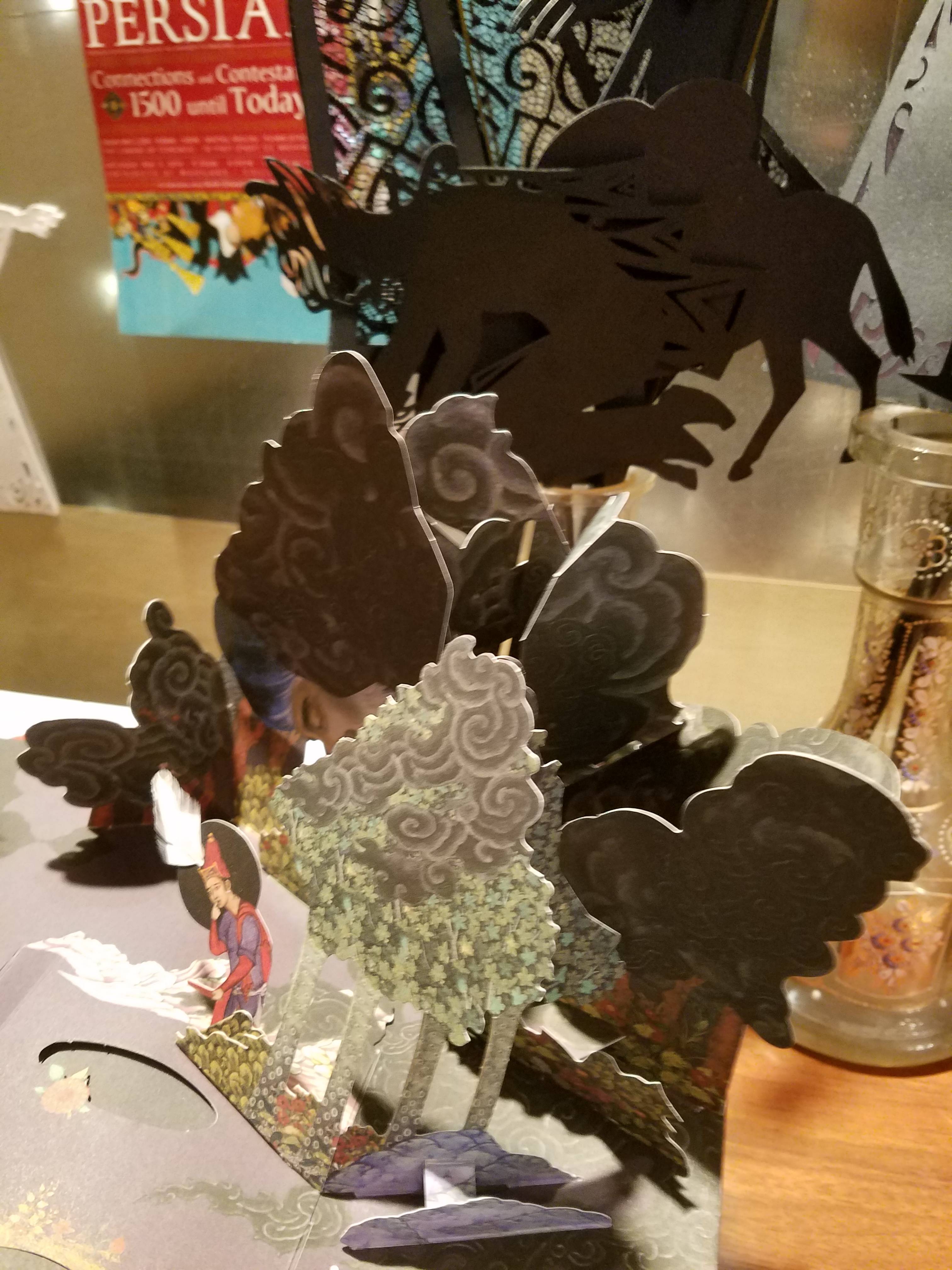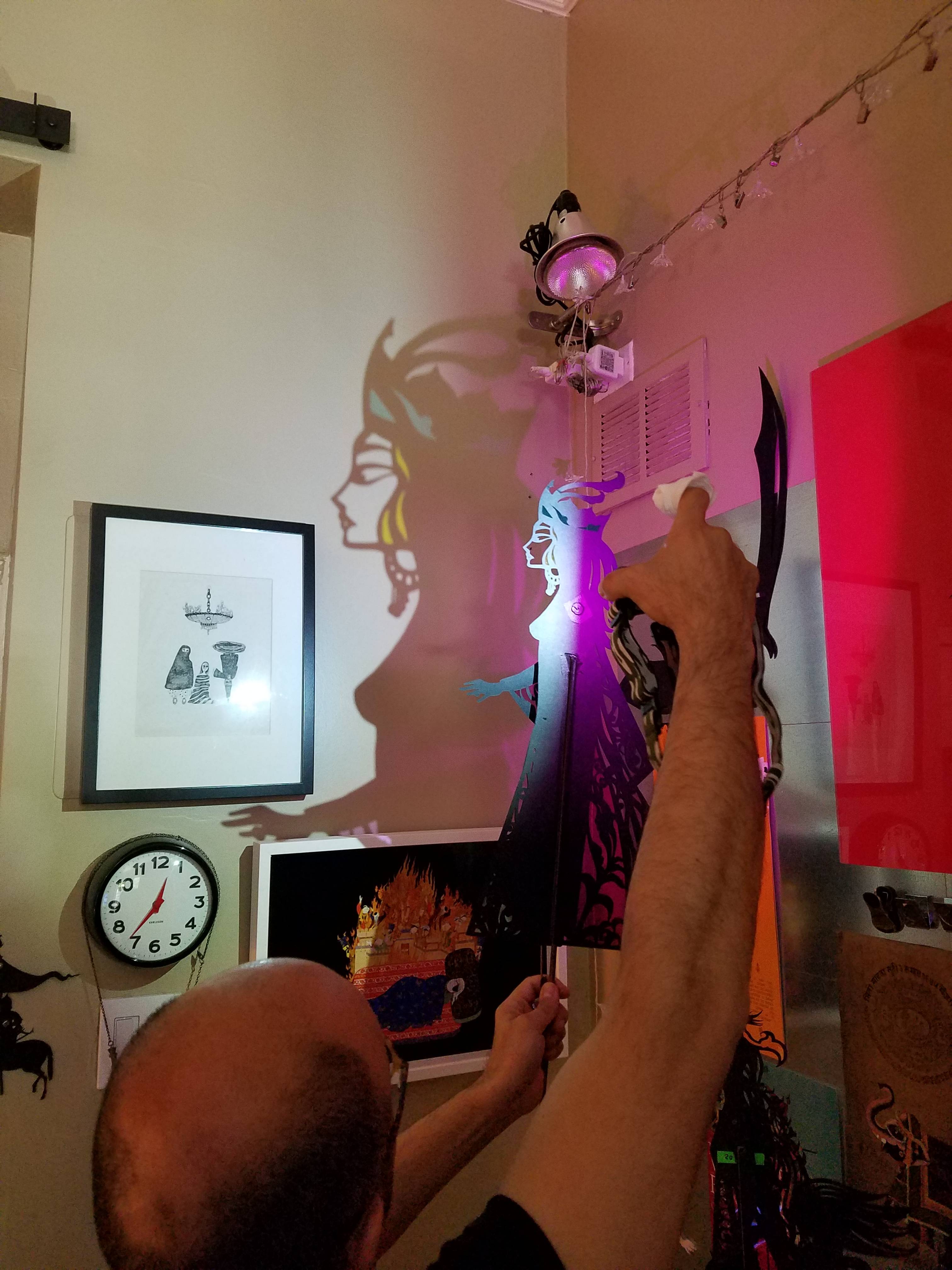You know how they call people political activists? I’m a cultural activist.
I’m sitting in the studio of Iranian artist Hamid Rahmanian, on the ground floor of his family’s living space. We are in a brownstone in Brooklyn close to the shoreline, bathed in gentle summertime sunlight and adjacent to the quietly cooing sidewalk. Hamid is easily winning the contest for noisiest presence in close proximity, and though he has a calm demeanor, his mind shifts intensely from topic to topic, following trains of thought into the far corners of the studio and unearthing books, projects, films, and artifacts, all to keep pace with his instanced focus.
Rahmanian has seemingly lived several artist’s lifetimes, with formative years as a designer, filmmaker, and gallery presence. But it’s this past decade that seemed to command much of our conversation, where his work has been committed to the illuminative adaptation of Iran’s national epic, as a published book titled Shahnameh: The Epic of the Persian Kings. I don’t use the adjective sparingly – much of his attention has been to the literal illumination of the manuscript through an impressively intricate set of methods including computer-assisted design, conceptual recreation, shadow theater, audio production, and more.

The artist casually describes the original source material: “The historical part is a combination of a lot of small stories, and is a bit disjointed (and a bit boring, to be honest with you), but the epic, mythological part, is all focused on one family — similar to Game of Thrones as an example — all connected together. And the strength of Ferdowsi’s poetic episodes also manifests in these two parts.”
It’s a bit challenging for me to accurately describe what is occurring on the pages of the imposingly large and heavy edition of Rahmanian’s Shahnameh, but you can luckily see some of his collaborative efforts at this link. Of additional interest is the artist’s attempts to “remove” himself from the finished creation, which he sees as a conceptual alignment with the historical work of artists from previous centuries who would work on these and similar texts.
“The way I illustrated [the main book] is very important. I collected over 8000 pieces from miniatures of manuscript and lithograph, from late 14th Century to mid-19th Century. Anything that’s been influenced by the Persian school of painting – from Mughal India to all the territory of the Ottoman Empire. So, every page you see is between 17 to 120 single elements from up to 33 manuscripts, all put together from that region. Also over 460 elements of layout, all connected to the text, and very little of it is purely decorative, every element is in the service of the storytelling.”
Are they from different eras, on the same page?
“Not only from different eras, but from different manuscripts, geographies, and so on. And it’s not only collage, it uses [digital techniques like] cloning and stitching, all of which is described in detail in a section at the end of the book. No pieces (except natural elements like trees and mountains) are reused or repeated from page to page.”

I asked the artist about where his personal relationship to the epic originated.
“First of all, Shahnameh is the national heritage or national identity of Iranians. The reason that to this day we Iranians are speaking Persian is because of Shahnameh. The region in North Africa, Egypt, Syria, that whole area, they lost their indigenous language to Arabic in the 7th century when the Arabs conquered it. But the Iranians kept the language alive because they had this book, they had the stories in this book, which Ferdowsi collected together as a kind of set of heroic verses — it’s the longest poem written by a single poet, ever. He kept the Persian language alive. To this day when you read Shahnameh, even though there is a complicated vocabulary in it at times, it’s understandable, you can follow the stories.
“I believe that literature and art is the highlight of the Iranian culture. What you mostly hear in the Western world is usually about the shortcomings of the culture. The human rights issues, the politics, the nuclear issues – all these things that are constantly in the media create this narrative about Iran. I wanted to break that narrative, to create something more positive and engaging, something that’s not just about current affairs. Look at the culture, instead of the politics associated with the culture.
“This epic doesn’t bind itself to the era.”
“This book has been praised for a thousand years, and now we can bring it to the people who are not part of elite academia or have a very high command of language. They can read this beautifully composed prose by Dr. Ahmad Sadri and connect to the epic and mythology of the Iranian plateau.”
Zahhak: The Legend of the Serpent King is Hamid’s most recently realized adaptation of Shahnameh. Working alongside partner and collaborator Melissa Hibbard as well as Simon Arizpe (a protege of famed pop-up book designer Robert Sabuda), Rahmanian injects a level of detail into the narrative that is at least as laborious and creative as his work in the full epic. As each page of this new, hand-assembled pop-up book is turned, the individual mechanics tell portions of the story, and even the physical movement of turning the pages themselves prompt meaningful narrative events and jolts of activity. In certain ways, it’s like a tiny, portable theatrical performance, with animated folds of paper that surround and crown kings or move celestial bodies.
This makes it an interesting companion to Feathers of Fire, the multimedia shadow puppet theatrical experience, conceived by Rahmanian and scheduled for October performances in LA. The Zahhak pop-up book will be released by legendary comics publisher Fantagraphics, and is intended for all ages.

The idea of rendering the epic in all of these different ways is to give it something of the universal, a solid method for increasing the longevity of an antiquated text. Still, some readers may consider the current formats in which this book exists to be in certain ways inaccessible, based on purchase price (current print editions of Shahnameh run between $78 and $125, with collectible editions costing as much as $550). Thankfully, the artist and his collaborators are presently working on a more affordable version with less illustrations, bringing the price to less than $40.
“This is a Shahnameh for the 21st Century, designed to be left for the next generation.”
Coming up is a semi-secretive project that will be a much more personally-present published work. As for the Shahnameh, Hamid Rahmanian has given ten devoted years to exploring it in virtually every dimension — it’s more than reasonable to expect that he’s excited to emerge from behind the curtain with the next phase of his expression.
Follow the artist Hamid Rahmanian and his diverse works at kingorama.com.
Photos by: Leonardo Faierman






